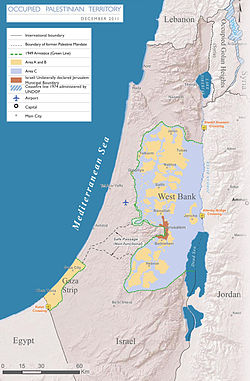


| Part of a series on the Israeli–Palestinian conflict |
| Israeli–Palestinian peace process |
|---|
The two-state solution is a proposed approach to resolving the Israeli–Palestinian conflict, by creating two states on the territory of the former Mandatory Palestine. It is often contrasted with the one-state solution, which is the establishment a single state in former Mandatory Palestine with equal rights for all its inhabitants. The two-state solution is supported by many countries, and the Palestinian Authority.[1] Israel currently does not support the idea, though it has in the past.[2]
The first proposal for separate Jewish and Arab states in the territory was made by the British Peel Commission report in 1937.[3] In 1947, the United Nations General Assembly adopted a partition plan for Palestine, leading to the 1948 Palestine war.[4][5] As a result, Israel was established on the area the UN had proposed for the Jewish state, as well as almost 60% of the area proposed for the Arab state. Israel took control of West Jerusalem, which was meant to be part of an international zone. Jordan took control of East Jerusalem and what became known as the West Bank, annexing it the following year. The territory which became the Gaza Strip was occupied by Egypt but never annexed. Since the 1967 Six-Day War, both the West Bank (including East Jerusalem) and Gaza Strip have been militarily occupied by Israel, becoming known as the Palestinian territories.
The Palestine Liberation Organization has accepted the concept of a two-state solution since the 1982 Arab Summit.[clarification needed][6] In 2017, Hamas announced their revised charter, which claims to accept the idea of a Palestinian state within the 1967 borders, but without recognising the statehood of Israel.[7] Diplomatic efforts have centred around realizing a two-state solution, starting from the failed 2000 Camp David Summit and the Clinton Parameters, followed by the Taba Summit in 2001. The failure of the Camp David summit to reach an agreed two-state solution formed the backdrop to the commencement of the Second Intifada, the violent consequences of which marked a turning point among both peoples’ attitudes.[8][9][10] A two-state solution also formed the basis of the Arab Peace Initiative, the 2006–2008 peace offer, and the 2013–14 peace talks.
Currently there is no two-state solution proposal being negotiated between Israel and Palestinians. The Palestinian Authority supports the idea of a two-state solution;[11] Israel at times has also supported the idea, but nowadays rejects the creation of a Palestinian state.[12] Long-serving Israeli Prime Minister Netanyahu in 2015 rejected a Palestinian state.[13] He again rejected a Palestinian state in June 2023.[14][15] Former Israeli PMs Ehud Barak and Ehud Olmert in late 2023 expressed support for a two-state solution.[16][17] Public support among Israelis and among Palestinians (measured separately) for “the concept of the two-state solution” etc. have varied between far above and far below 50%, depending partly on how the question was phrased.
The major points of contention include the specific boundaries of the two states (though most proposals are based on the 1967 lines), the status of Jerusalem, the Israeli settlements and the right of return of Palestinian refugees. Observers have described the current situation in the whole territory, with the Israeli occupation of the West Bank and blockade of the Gaza Strip, as one of de facto Israeli sovereignty.[18][19] The two-state solution is an alternative to the one-state solution and what observers consider a de facto one-state reality.[20][21][22]
Following the 2023 Hamas-led attack on Israel and the subsequent Israel–Hamas war, multiple governments renewed the long-dormant idea of a two-state solution. This received serious pushback from Israel's government, especially from Prime Minister Benjamin Netanyahu. On 26 September 2024, Saudi Foreign Minister Prince Faisal bin Farhan Al Saud and Norway's Foreign Minister Espen Barth Eide co-chaired a meeting of representatives of about 90 countries, held on the sidelines of the UN General Assembly, to launch a global alliance to strive for a two-state solution.[23][24][25][26][27]
- ^ "Palestinian Authority ready to work with an Israeli government that backs two-state solution: PM Shtayyeh". CBC News. 1 February 2024. Retrieved 3 September 2024.
- ^ Magid, Jacob (2024-07-18). "Knesset overwhelmingly passes motion rejecting Palestinian statehood, days before PM's US trip". The Times of Israel. Retrieved 2024-08-18.
- ^ Morris, Benny (2009-04-28), "The History of One-State and Two-State Solutions", One State, Two States: Resolving the Israel/Palestine Conflict, Yale University Press, pp. 28–160, doi:10.2307/j.ctt1np7rh.7, ISBN 978-0-300-15604-1, retrieved 2024-06-28
- ^ Sabel, Robbie, ed. (2022), "The 1947 Partition Plan", International Law and the Arab-Israeli Conflict, Cambridge: Cambridge University Press, pp. 93–101, doi:10.1017/9781108762670.006, ISBN 978-1-108-48684-2, retrieved 2023-10-31
- ^ The Question of Palestine and the UN, "The Jewish Agency accepted the resolution despite its dissatisfaction over such matters as Jewish emigration from Europe and the territorial limits set on the proposed Jewish State."
- ^ Tessler, Mark A. (1994). A History of the Israeli–Palestinian Conflict. Bloomington, Indiana: Indiana State University. p. 718. ISBN 978-0253208736.
- ^ "Hamas accepts Palestinian state with 1967 borders". Al Jazeera. 2 May 2017. Retrieved 3 November 2023.
- ^ Palti, Zohar (2023-09-08). "The Implications of the Second Intifada on Israeli Views of Oslo". The Washington Institute. Retrieved 2024-04-03.
- ^ "Background & Overview of 2000 Camp David Summit". Jewish Virtual Library. Retrieved 2024-04-03.
- ^ "Second Intifada". Makan. Retrieved 2024-04-03.
The Second Intifada starkly demonstrated the failure of years of negotiations, and marked a turning point in both internal Israeli and Palestinian politics.
- ^ "Palestinian Authority ready to work with an Israeli government that backs two-state solution: PM Shtayyeh". CBC News. 1 February 2024. Retrieved 3 September 2024.
- ^ Magid, Jacob (2024-07-18). "Knesset overwhelmingly passes motion rejecting Palestinian statehood, days before PM's US trip". The Times of Israel. Retrieved 2024-08-18.
- ^ Cite error: The named reference
ynet,2015was invoked but never defined (see the help page). - ^ "Palestinians furious over Netanyahu claims that Israel must 'crush' statehood ambitions". The Jerusalem Post | JPost.com. 2023-07-01. Retrieved 2024-07-26.
- ^ "Netanyahu's call to block creation of Palestinian state sparks fury, condemnation". Arab News. 2023-06-26. Retrieved 2024-07-26.
- ^ Cortellessa, Eric (2023-11-06). "Former Israeli Prime Minister: Israel's Endgame in Gaza Should be a Palestinian State". TIME. Retrieved 2023-12-21.
- ^ Cite error: The named reference
Olmert2023was invoked but never defined (see the help page). - ^ Iraqi, Amjad (2021-01-12). "Why B'Tselem is calling Israel an apartheid regime, from the river to the sea". +972 Magazine. Retrieved 2023-11-28.
- ^ "B'Tselem (Document): A Regime of Jewish Supremacy from the Jordan River to the Mediterranean Sea: This Is Apartheid". Institute for Palestine Studies. January 12, 2021. Retrieved November 28, 2023.
- ^ Iraqi, Amjad (2021-01-12). "Why B'Tselem is calling Israel an apartheid regime, from the river to the sea". +972 Magazine. Retrieved 2023-11-28.
- ^ "B'Tselem (Document): A Regime of Jewish Supremacy from the Jordan River to the Mediterranean Sea: This Is Apartheid". Institute for Palestine Studies. January 12, 2021. Retrieved November 28, 2023.
- ^ Barnett, Michael; Brown, Nathan; Lynch, Marc; Telhami, Shibley (2023-04-14). "Israel's One-State Reality". Foreign Affairs. Vol. 102, no. 3. ISSN 0015-7120. Retrieved 2024-04-03.
- ^ Cite error: The named reference
:15was invoked but never defined (see the help page). - ^ Cite error: The named reference
:16was invoked but never defined (see the help page). - ^ Cite error: The named reference
:17was invoked but never defined (see the help page). - ^ Cite error: The named reference
:18was invoked but never defined (see the help page). - ^ Faisal bin Farhan Al Saud (2024-10-02). "Saudi foreign minister: A two-state solution is more urgent than ever". Financial Times. Retrieved 2024-10-04.